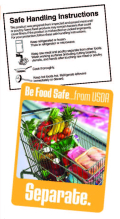
Product safety issues demand-and get-center-stage attention. What will be expected of food and beverage packagers? How will they hold up when the spotlight is on them?
Also see timeline of Key Regulations During the Last 10 Years
In preparing for this column, I reviewed the article that I wrote forFood & Drug Packaging’s 40th Anniversary issue 10 years ago. Many of the issues that we were dealing with back then are still hot issues today (maybe even hotter). But one stands out as having the greatest potential for impacting all segments of the food and beverage markets, and that is safety.
Coupled with the growing skepticism aimed at all of business due to the financial crisis, manufacturers must fully understand their products-how they are made and what is used to make them-so that their safety can be defended under potentially intense governmental and public scrutiny.

We need to protect against E.coli O157:H7 (pictured), Salmonella and listeria, common bacteria that threaten our food supply.
Enter stage right…and left
To hear the current administration tell it, all of our food safety problems began eight years ago. Because of political meddling and underfunding by the previous administration, the Food and Drug Administration (FDA) became a lackey for industry and completely dysfunctional.In fact, significant media attention began to focus on the safety of the food supply during the Clinton administration. It was then that E.coli O157:H7 almost became a household term. It was then that we started to hear of “mad cow” (bovine spongiform encephalopathy or BSE) disease.
It was also then that the government took significant steps to try to prevent food-borne illnesses at the consumer level with safe handling instructions for high-risk products, such as fresh meat and poultry products.
Back then, the U.S. Department of Agriculture (USDA) implemented hazard analysis and critical control point (HAACP) programs at the processor level as a way to reduce or eliminate the potential for contamination of foods. FDA followed suit for seafood.
These programs were roundly criticized as being ineffective because they reduced the need for paid government inspectors. However, the success of HAACP in reducing food-borne illnesses is difficult to dispute.
Indeed, HAACP has done well enough that a strong push is now being made to implement a similar program for packaging operations and for raw produce that would begin at the farm and end at the retail store.
Is HAACP a panacea, an absolute guard against food contamination ever occurring? Obviously not. But by placing the responsibility for food safety on those who are best able watch over it, great strides have been made.
Bad actors
One thing that no program or law can prevent is nefarious individuals who ignore or subvert food safety controls to line their pockets. Over the last couple of years, some of our biggest food safety problems have occurred because of such reckless or intentionally bad behavior.We begin with melamine-contaminated pet food. Some unscrupulous businesses in China decided to spike wheat gluten added to pet food with melamine, a chemical used in a number of plastic products, to falsely show higher levels of protein than was actually present. It resulted in the unfortunate deaths of literally hundreds of pets in the U.S. Even worse was a similar spiking of milk powder products, which were intended for use by children. Although we have been fortunate to avoid a loss of life here in the U.S., many infants and toddlers in China were not so fortunate.
The corrupt are not all in China, though. One slaughterhouse in California was forced to issue the largest beef recall in history, 143 million pounds, based on an allegation that it had permitted the slaughter of downer cows, which carry an increased risk of BSE. And maybe the most notorious is the Peanut Co. of America, which is now facing allegations of selling contaminated peanut butter after receiving positive test results for salmonella.
The congressional (and media) attack on FDA as being responsible for these outbreaks is unfair to say the least. We still have the safest and healthiest food supply in the world, and that is largely due to the system that is in place, which expects food companies and their suppliers to act responsibly. It’s also due to the dedication of the FDA in assisting companies in eliminating food contamination that can occur accidentally, rather than by neglect or intentional action.

In addition to “Safe Handling Instructions” on fresh meat and poultry, the USDA stepped up its food safety education program in 2006 with a direct-to-consumer campaign that teaches four key messages: Clean, Separate, Cook and Chill.
Packaging faces tough critics
Issues on the safety of the food and beverage supply do not stop with the product itself. In recent years, we have seen more scrutiny being paid to the chemical substances that are used in packaging.Bisphenol-A (BPA) has got to be this past year’s poster child (“Don’t let this happen to you”) for the chemical industry. Facing the perfect storm of a well-mounted attack by an environmental organization, a less than stellar report from the National Toxicology Program and a determination of risk to the health of infants by the Canadian government, bottle manufacturers who used BPA faced over-the-top media attention, consumer outcry and political indignation. This resulted in the deselection of its products by national retailers and the consideration of legislation that could get these products banned for good. The storm will die away; however, the damage done to products that FDA and the European Food Safety Agency (EFSA), among other government bodies, has found to be safe time and again is not likely to pass.
Phthalates of all sorts have taken a similar hit, six of them having been banned by Congress from use in children’s products, even though scientific evidence suggests that only some are of concern-and none of these are used in food packaging materials to speak of. Also, noteworthy is the attack launched against grease-resistant fluorotelomer-based products that, again, FDA and EFSA have found safe for use.
Role of Congress
Where trouble lurks, Congress is soon to follow. A host of food safety legislation has been proposed this year, and the chances are better now than in the past that some significant changes will be made at FDA. Likely aspects of any legislation to be considered by the Congress include adulteration reporting requirements, mandatory recall authority, expanded access to facility records, suspension of facility registrations and regularly required FDA inspections of such facilities.Maybe the most far-reaching measure that could fundamentally affect the function and mission of the agency is one that is being proposed by the chairman of the House Commerce and Energy Committee, Henry Waxman. His bill would give FDA regulatory authority over tobacco products. The scope of the issue and the resources that would be necessary for this public health agency to deal with tobacco regulation will be significant and a potential drain of needed funds for other programs at the agency.

Dr. Margaret Hamburg, nominated for the position of FDA Commissioner, has yet to be confirmed.
A new act from a single food agency?
For at least the last 20 years, there have been periodic calls from congressional representatives and others for a single food safety agency, one that would combine the Center for Food Safety and Applied Nutrition at FDA with the Food Safety and Inspection Service at USDA. Given the attention that food safety issues are commanding these days, support for such a notion is growing.The Obama administration may be laying the groundwork to support such an initiative. First, the rumors are rampant that the President’s nominee for FDA commissioner, Margaret Hamburg, and designee for principal deputy commissioner, Joshua Sharfstein, will split the commissioner’s job. The talk is that Dr. Hamburg would take on food and Sharfstein would handle drugs, devices and the rest.
Second, the President has ordered the formation of a Food Safety Working Group, which is tasked with the job of better integrating food safety regulation. That could result not only in the unification of food safety authorities at the federal level, but also the usurpation of authority from state officials, which FDA relies upon to conduct food safety inspections and for which it was roundly criticized in the peanut debacle.

It’s possible that the Food and Drug Administration will be split into two separate groups: one to handle foods, the other for drugs.
What's the finale?
A recurring theme of the new administration is responsibility. The President has blamed the failure of the car industry on their lack of responsibility in developing energy efficient vehicles. He has blamed the financial crisis on Wall Street on greed, avarice and irresponsibility. Indeed, even the President’s proposed budget is called “A New Era of Responsibility.” Obviously, the corner on responsibility is his.The likelihood that other industries, including the food industry, will escape the barb of irresponsibility is slim. Regardless of the job the food industry as a whole does in policing itself, it is already being castigated for the failures of a few. Given the current political climate, that means more regulation and possibly even the development of an adversarial relationship to replace the cooperative spirit that has long served the interests of industry, the agency and the American public.
With greater attention from the agency will also come greater attention from the press, and the reporting of further flimsy accusations about chemical additives or substances used in food or food packaging materials. Unless prepared, the consequences could be as devastating as they have been for users of BPA.
So be ready. Ready with solid science that shows your products to be safe; ready with a public relations crew who knows how to answer the hard questions and defuse a situation before it gets out of control; and ready to point to staff at the FDA who can say that they have reviewed your data and found your product to be safe.

